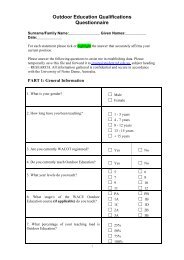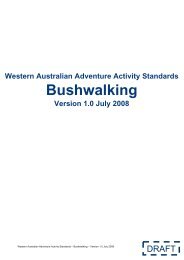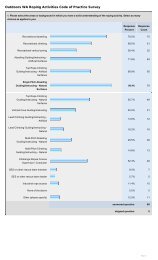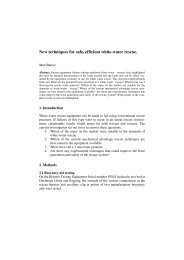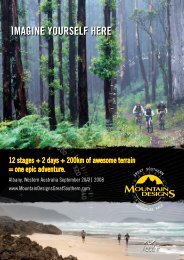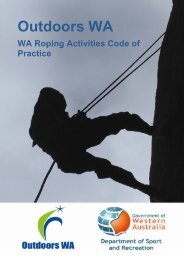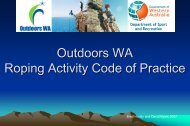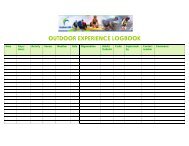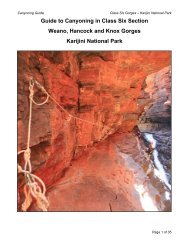Outdoor Adventure Activities Benefits Catalogue - Outdoors WA
Outdoor Adventure Activities Benefits Catalogue - Outdoors WA
Outdoor Adventure Activities Benefits Catalogue - Outdoors WA
You also want an ePaper? Increase the reach of your titles
YUMPU automatically turns print PDFs into web optimized ePapers that Google loves.
5.3. Participation in physical activity and outdoor adventure activitiesIn a 1997 survey of over 2,000 Year 8 and Year 10 students in New South Wales schools itwas found that during summer terms 80.9% and 85.9% of Year 8 and 120 boys respectively.While for girls, 80.8% and 77.7% of Year 8 and 10 respectively were adequately active asmeasured by the Adolescent Physical Activity Recall Questionnaire (Booth, Okely, Chey,Bauman, & Macaskill, 2002). During winter, these figures dropped to 75.6% and 84.0% forthe boys and 69.4% and 66.0% for girls. It was concluded that the majority of students wereadequately active, however there were clear differences between boys and girls and therewere significant differences for girls from different cultural backgrounds (.e.g. Middle Eastand Asia) who would require more targeted approaches to encourage physical activity in thefuture. Other studies of adolescents’ levels of physical activity levels have highlighted thatthere is a decrease with age, particularly for females (Martin, A. J., Tipler, Marsh, Richards,& Williams, 2006).Given the concerns expressed in many of these previous reports about the level of physicalactivity and the suggestion that participating in outdoor activities can have life-long healthand social benefits, it is important to consider the current participation levels of Australians.There is little available Australian participation data to draw upon that is of relevance tooutdoor adventure activities. The Participation in Exercise, Recreation and Sport SurveyAnnual Report (ERASS) (Australian Sports Commission, 2007) provides one annual sourceof information, however the detail is limited with respect to outdoor activities. However,even that is only of people aged 15 years and over. Those activities that are specificallyreferred to that are of relevance to this report are:• bushwalking,• canoeing/kayaking,• cycling (though there is no distinction between road cycling, mountain biking orBMX),• ice and snow sports (this includes ice skating together with skiing or snowboarding),• rock climbing (but with no split between indoor or outdoor climbing).In the ERASS for 2006 (Australian Sports Commission, 2007) it was reported that 66.0% ofpeople aged 15 years or over had participated in exercise, recreation or sport at least once perweek during the previous 12 months. As shown in Table 7, of all activities (by number ofparticipants), bushwalking, with 774,000 participants, was ranked eighth, ahead of majorteam sports such as soccer/football (697,400), netball (593,900), rugby league (209,800), andrugby union (165,300). The most popular activities overall were walking (6,001,700),aerobics/fitness (3,161,300), swimming (2,256,900) and cycling (1,682,800).Participation rates across all activities were highest in the Australian Capital Territory,Western Australia and Tasmania, while New South Wales, Queensland, and the NorthernTerritory had the lowest participation rates. Without further information it is impossible todetermine whether this is a result of resource access and availability, social factors or policyinitiatives.Page 19






